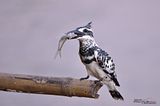Today was my first time going out with the new 550D. I woke up early in the morning around 7AM and saw that the sky was fully covered with dark clouds. I don't mind overcast weather as long as it doesn't rain. I grabbed my handy umbrella and put it into my bag before riding straight to my favourite birding site near Mae Taeng River just about 1.5km away from my house. The air was much cooler and fresher than yesterday when there was almost no cloud in the sky at all. As I arrived at the place, a flock of about 10 Red Collared-Doves (Streptopelia tranquebarica humilis) flushed up from roadside grass and perched up on the bare bamboo tree. Several Greater Coucals (Centropus sinensis intermedius) were coming up from the wet grass to dry their wings on the treetops. A large flock of Baya Weavers (Ploceus philippinus angelorum) was also feeding in the tall grass next to the road, but they were just too shy. Just as I was wandering around the area hoping for something to show up in the range of my lens, this immature Racket-tailed Treepie (Crypsirina temia) came sneaking up from the dense vegetation and posed as the first bird to be photographed by my new camera.




Immature Racket-tailed Treepie (Crypsirina temia)
 The Racket-tailed Treepie is a fairly common resident bird of open woodland and cultivated area. It is one of the several corvids that can be found near my house, others include the Rufous Treepie (Dendrocitta vagabunda kinneari), Red-billed Blue Magpie (Urocissa erythrorhyncha magnirostris), Eurasian Jay (Garrulus glandarius leucotis) and Eastern Jungle Crow (Corvus levaillantii). I've seen a small flock of Racket-tailed Treepies in this area once last September but couldn't get any photo, since they're normally very shy. The immature I found this morning was, however, unexpectedly obliging. The iris of these birds will turn bright sky blue once they become adult. The bird hanged around with me for a few minutes, playing hide and seek among the lush green vegetation, before flying out into the distance. At the same place, there was an immature Black Drongo (Dicrurus macrocercus cathoecus) perching waiting for its prey as well. It's funny to me how they can look superficially similar when they're in the same setting.
The Racket-tailed Treepie is a fairly common resident bird of open woodland and cultivated area. It is one of the several corvids that can be found near my house, others include the Rufous Treepie (Dendrocitta vagabunda kinneari), Red-billed Blue Magpie (Urocissa erythrorhyncha magnirostris), Eurasian Jay (Garrulus glandarius leucotis) and Eastern Jungle Crow (Corvus levaillantii). I've seen a small flock of Racket-tailed Treepies in this area once last September but couldn't get any photo, since they're normally very shy. The immature I found this morning was, however, unexpectedly obliging. The iris of these birds will turn bright sky blue once they become adult. The bird hanged around with me for a few minutes, playing hide and seek among the lush green vegetation, before flying out into the distance. At the same place, there was an immature Black Drongo (Dicrurus macrocercus cathoecus) perching waiting for its prey as well. It's funny to me how they can look superficially similar when they're in the same setting.













.jpg)

4 comments:
Two wonderful subjects and super results with the new camera! Love the different shapes of their faces.
Good results with the new 550D, join the club again. I find it difficult getting shots of birds that have black heads because it's hard to highlight the eye, but you managed it here.
You do really have splendid species and it looks like you already got the 550D in hand! Great pictures and great job!
Great name for a bird!
Post a Comment